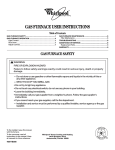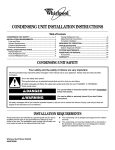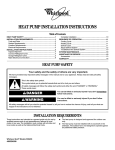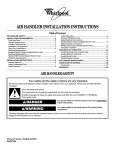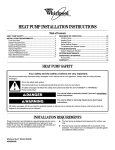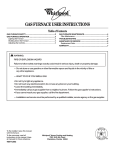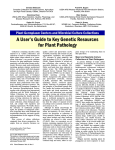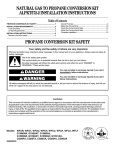Download Whirlpool GOLD W4GH6 Instruction manual
Transcript
MULTIPOSITIONAL CASED EVAPORATOR COIL INSTALLATION INSTRUCTIONS Table of Contents EVAPORATOR COIL SAFETY .......................................................1 INSTALLATION REQUIREMENTS ................................................2 Tools and Parts ............................................................................2 System Requirements..................................................................2 Location Requirements ................................................................2 Drain Requirements .....................................................................2 INSTALLATION INSTRUCTIONS ..................................................2 Inspect Shipment .........................................................................2 Prepare Evaporator Coils.............................................................3 Verify Orifice Size .........................................................................3 Assemble Distributor/Orifice ........................................................3 Install Evaporator Coil ..................................................................3 Field Conversion for Horizontal Airflow........................................5 Install Auxiliary Drain Pan (If required) .........................................5 Install Condensate Drains ............................................................6 Connect Refrigerant Lines ...........................................................6 ASSISTANCE OR SERVICE ...........................................................6 WARRANTY ....................................................................................7 EVAPORATOR COIL SAFETY Your safety and the safety of others are very important. We have provided many important safety messages in this manual and on your appliance. Always read and obey all safety messages. This is the safety alert symbol. This symbol alerts you to potential hazards that can kill or hurt you and others. All safety messages will follow the safety alert symbol and either the word “DANGER” or “WARNING.” These words mean: You can be killed or seriously injured if you don't immediately follow instructions. You can be killed or seriously injured if you don't follow instructions. All safety messages will tell you what the potential hazard is, tell you how to reduce the chance of injury, and tell you what can happen if the instructions are not followed. The California Safe Drinking Water and Toxic Enforcement Act requires the Governor of California to publish a list of substances known to the State of California to cause cancer, birth defects, or other reproductive harm, and requires businesses to warn of potential exposure to such substances. WARNING: This product contains a chemical known to the State of California to cause cancer, birth defects, or other reproductive harm. This appliance can cause low-level exposure to one of the substances listed: formaldehyde. 065715702 INSTALLATION REQUIREMENTS These instructions are intended as a general guide only for use by qualified persons and do not supersede any national or local codes in any way. Compliance with all local, state, or national codes pertaining to this type of equipment should be determined prior to installation. Read this entire instruction manual, as well as the instructions supplied in separate equipment, before starting the installation. All models are designed for indoor installation only. Install the conditioned air plenum, ducts and air filters (not provided) in accordance with NFPA 90B Standard for the Installation of Warm Air Heating and Air-Conditioning Systems (latest edition). Air filters (not provided) must be listed as Class 2 furnace air filters. Tools and Parts Gather the required tools and parts before starting installation. Read and follow the instructions provided with any tools listed here. ■ ■ ■ Airflow greater than 450 CFM per 12,000 Btu/h as noted above can cause water spray to blow into air duct. All air passing over the evaporator coil must be filtered. Evaporator coils are matched to specific outdoor units to obtain an ARI rating. The orifice installed on each evaporator coil is chosen for the Btu/h capacity of the coil. The factoryinstalled orifice size is stamped on the orifice body, and is identified with a label on the orifice extension stub. The orifice size must match the size called for on the refrigerant charging table found on the outdoor unit. A selection of replacement orifices is available from the distributor. Location Requirements When the horizontal evaporator coil is installed in an attic, above a finished ceiling, or in any location where condensate overflow would result in property damage, the installer must provide an auxiliary drain pan in addition to the primary and secondary drains. The auxiliary drain pan must be connected to a drainage system separate from the primary condensate drain. Tools Needed ■ ■ ■ ■ Torch Tape measure Flat-blade screwdriver ¹⁄₄" nut driver ■ ■ ■ ■ ¹³⁄₁₆" open end wrench Level Drill ¹⁄₈" drill bit Drain Requirements ■ ■ Parts Needed Check local codes. Check the existing drain configuration before purchasing parts. ■ ■ Field-fabricated auxiliary drain pan (in some installations) Sheet metal screws (4) Parts Supplied ■ Evaporator coil may be provided as a separate coil or mounted in a duct extension. ■ ■ All vertical mount models come from the factory with right and left front drain connections. Multiposition models come from the factory with right and left front drain connections for vertical and horizontal installations. Minimum ¾" (1.9 cm) copper or PVC drain lines are recommended. NOTE: Check local codes before connecting drain lines to an existing drainage system. A field-fabricated auxiliary drain pan, with a drainpipe to the outside of the building, is required in all installations over a finished living space or in any area that may be damaged by overflow from the main drain pan. In some localities, local codes may require an auxiliary drain pan for any horizontal installation. System Requirements IMPORTANT: ■ The blower and duct system must be properly sized in order to provide adequate cooling and heating performance. For proper cooling operation, the airflow through the indoor coil should be 350 to 450 CFM per ton of cooling capacity (or 350 to 450 CFM per 12,000 Btu/h) based on the rating of the outdoor unit. INSTALLATION INSTRUCTIONS Inspect Shipment WARNING Excessive Weight Hazard Use two or more people to move and install evaporator coil. Failure to do so can result in back or other injury. 1. Check the evaporator coil rating plate to confirm specifications are as ordered. 2 2. Upon receipt of evaporator coil, inspect it for possible shipping damage. Examine the evaporator coil inside the carton if the carton is damaged. If damage is found, it should be noted on the carrier’s freight bill. Damage claims should be filed with the carrier immediately. Claims of shortages should be filed with the seller within 5 days. NOTE: If any damages are discovered and reported to the carrier, do not install the evaporator coil, because your claim may be denied. Orifice Extension Stub—After Removal of Shipping Strap Prepare Evaporator Coils A IMPORTANT: ■ This evaporator coil was manufactured containing a dry air precharge of 10 psi. Slowly remove the rubber line seal plugs to relieve the dry air precharge pressure. ■ Before installation, wash the coil finned areas with a mild soap solution to remove shipping and handling contamination. B A. Orifice extension stub B. Ring seal 5. Slide the brass hex nut over the orifice extension stub. A B C D A G B C A. Evaporator coil inside housing B. Left horizontal drain connections C. Right horizontal drain connections Verify Orifice Size IMPORTANT: The proper orifice size is dependent on indoor coil/ outdoor unit combination and application. Consult the outdoor unit information to determine if the indoor unit has the correct orifice installed. Assemble Distributor/Orifice 1. Remove the brass hex nut from distributor/orifice assembly. 2. Remove the line seal plug from the orrifice assembly. 3. Unscrew and remove the shipping strap from the orifice extension stub. Remove the orifice extension stub from the panel. 4. Relocate the ring seal to the stub end of the orifice extension stub as shown. Orifice Extension Stub—Before Removal of Shipping Strap A B E F A. Distributor fitting D. Orifice extension stub B. Piston orifice E. 0.812" Brass hex nut C. Ring seal (supplied) F. Brass hex fitting G. Mounting flange 6. If a change in orifice is required, remove the factory-installed orifice with an orifice extractor tool. 7. Insert the proper orifice into the fitting, seal end first. Make sure the orifice is free to move in the fitting. 8. Assemble the brass hex nut and orifice extension stub onto the distributor/orifice assembly as shown. NOTE: Overtightening the brass hex nut will crush the gasket and might result in a system leak or stuck piston. 9. Dispose of/recycle all packaging and unused parts. Install Evaporator Coil IMPORTANT: ■ The evaporator coil must be installed in the discharge (supply) air of a gas or oil furnace. Do not install an evaporator coil in the return air, or excessive condensation will occur within the furnace. ■ Install the evaporator coil level with the drain connection to ensure proper drainage. ■ To avoid damage to the plastic drain pan, minimum spacing is required between the drain pan and a furnace heat exchanger. A minimum spacing of 2" (5.1 cm) is required for a gas furnace. A minimum spacing of 4" (10.2 cm) is required for an oil-fired furnace. See “Evaporator Coil Drain Pan Clearances.” Evaporator Coil Drain Pan Clearances C A. Orifice extension stub B. Shipping strap A C. Ring seal B C A. Furnace heat exchanger B. Gas—2" (5.1 cm) minimum; Oil-fired—4" (10.2 cm) minimum C. Plastic drain pan 3 Install Splash Shield—Horizontal Installation Vertical Installations 1. Insert lip of splash shield behind drain pan edge. 2. Align splash shield so that it slopes toward the horizontal drain pan. A A B B C A. Splash shield B. Slope of splash shield Position the evaporator coil on the outlet of the furnace using sheet metal screws. The evaporator coil should be level, or pitched slightly toward the drain connection. Airflow should be set to 350 CFM per ton. Install splash shield (provided) on the evaporator coil outlet. The bottom flange of the splash shield should rest on the horizontal drain pan. The sides of the splash shield should be attached to the duct flanges with sheet metal screws (not provided). See “Install Splash Shield—Horizontal Installation.” ■ ■ ■ A C. Water trough D. Horizontal drain pan 3. Using holes in splash shield as a guide, drill four ¹⁄₈" (3.2 mm) holes into coil duct mounting flange. Horizontal Installations ■ C D A. Evaporator coil—inside housing B. Left horizontal drain connections C. Right horizontal drain connections B B A C A. Holes for mounting splash shield to duct flanges when horizontal drain pain is flush with top of housing B. Holes for mounting splash shield to duct flanges when horizontal drain pan is 2" (5.1 cm) shorter than top of housing. C. Do not use these holes. C 4. Fasten the splash shield to the duct mounting flange with 4 sheet metal screws (field supplied). A C E D B F A. Splash shield B. Evaporator coil—standard horizontal application— left-hand installation shown, right-hand installation typical C. Furnace D. Evaporator coil—counterflow horizontal application— right-hand installation shown, left-hand installation typical E. Transition F. 12" (30.5 cm) minimum NOTE: All horizontal applications must have splash shield attached to coil case. C A A. Duct flange B. Sheet metal screws 4 C. Splash shield Upflow Position—Coil Inside Housing Field Conversion for Horizontal Airflow 1. Remove the front panels from the unit. 2. Pull the coil assembly from the housing. 3. Remove the horizontal drain pan and reinstall it to the opposite side of the coil. NOTE: The horizontal drain pan must have the drain plugs closed in the rear of the unit. 4. Remove the top cap. 5. Remove the water diverter, and reinstall it to the opposite slab. 6. Replace the top cap. 7. Apply sealant to seal any air gaps. Upflow Position—Before Conversion A A. Front flange—cut and folded back Upflow Position—Panel Installed NOTE: It may be necessary to notch out a hole in the access panel to allow access to the suction header. A B C Upflow Position—After Conversion A. Suction header B. Old drain connection—sealed C. Horizontal drain connections Install Auxiliary Drain Pan (if required) ■ ■ ■ 8. Cut the front flange on the housing and fold it back to allow access to the horizontal drain connections. 9. Slide the coil assembly back into the housing. NOTE: If the unit is equipped with a sheet metal housing adapter, it will have to be moved to the opposite side of the housing. 10. Reinstall the piping panel to the housing. 11. Cut a hole in the access panel to allow access to the horizontal drain connections. 12. Reinstall the access panel to the housing. 13. Seal old drain connection hole in the piping panel to avoid air leakage. ■ See “Location Requirements” for furnace installation configurations that require an auxiliary drain pan. Counterflow installations located directly over objects that can be damaged by condensate, such as in an installation on a second floor over a finished ceiling, require an auxiliary drain pan. The auxiliary drain pan should be installed below the supply plenum. It should be at least 2" (5.2 cm) deep and at least 2" (5.2 cm) larger in all directions than the supply plenum. A separate drain line from the auxiliary drain pan to an open drain should be provided. The open drain should be visible so that any water coming from the auxiliary drain can be seen as an indicator that the primary drain is plugged, which should be investigated and corrected. 5 Install Condensate Drains The evaporator coil is provided with ³⁄₄" (1.9 cm) NPT condensate drain connections. The vertical drain connections are visible and the horizontal drain locations are covered by factory-installed knockouts. Select the drain location appropriate for the application. Remove the appropriate knockout for horizontal applications. Make sure the evaporator coil is level with the drain opening so that the drain pan will empty completely without leaving water standing in the pan. 1. Connect primary drain line connection to the drain pan (large hole). 2. Connect secondary drain line connection to the drain pan (small hole). Route the secondary drain to empty at a location easily seen, so that any drainage coming from that line would be noticed. If there is drainage from the secondary drain line, a problem exists with the primary drain system, which should be investigated and corrected. NOTE: Use thread sealant on drain pan fittings. Install drain lines hand tight. Do not overtighten. 3. Install a 3" (7.6 cm) trap in both the primary and secondary drain lines as close to the the evaporator coil as practical. Make sure the top of the trap is below the connection to the drain pan to allow complete drainage of the pan. NOTE: Horizontal runs must also have an anti-siphon air vent (standpipe) installed ahead of the horizontal run. See “Typical Condensate Drain Connection.” An extremely long horizontal run may require an oversized drain line to eliminate air trapping. Typical Condensate Drain Connection (secondary drain not shown) B A C G D E F H A. Evaporator coil B. Drain connection C. Drain line D. 1" (2.5 cm) minimum E. 12" (30.5 cm) maximum F. 3" (7.6 cm) minimum G. Anti-siphon air vent for horizontal runs H. Drain trap NOTE: Do not install the evaporator coil without a drain trap. The condensate drain is on the negative pressure side of the blower; therefore, air being pulled through the condensate line will inhibit positive drainage without a proper trap. 4. Route the drain line to the outside or to an appropriate drain. Drain lines must be installed so they do not block service access to the front of the evaporator coil. A 24" (61 cm) clearance is required for filter, coil, or blower removal and service access. NOTE: Check local codes before connecting the drain line to an existing drainage system. 5. Insulate the drain lines where sweating could cause water damage. Test condensate drain pan and drain line after installation 1. Pour several quarts of water into drain pan, enough to fill drain trap and line. 2. Check that the drain pan is draining completely, no leaks are found in drain line fittings, and water is draining from the end of the primary drain line. 3. Correct any leaks found. Connect Refrigerant Lines Refrigerant lines must be connected by a licensed, EPA certified refrigerant technician in accordance with established procedures. IMPORTANT: Connecting refrigerant lines must be clean, dehydrated, refrigerant-grade copper lines. Evaporator coils should be installed only with specified line sizes for approved system combinations. Use care with the refrigerant lines during the installation process. Sharp bends or possible kinking in the lines will cause a restriction. Do not remove the caps from the lines or system connection points until connections are ready to be completed. 1. Route the suction and liquid lines from the fittings on the indoor coil to the fittings on the outdoor unit. Run the lines in as direct a path as possible, avoiding unnecessary turns and bends. 2. Ensure that the suction line is insulated over the entire exposed length and that both suction and liquid lines are not in direct contact with floors, walls, ductwork, floor joists, or other piping. 3. Connect the suction and liquid lines to the evaporator coil. 4. To avoid damaging the rubber grommets in the cabinet while brazing, slide the rubber grommets over the refrigerant lines until they are away from the heat source. 5. Braze with an alloy of silver or copper and phosphorus with a melting point above 1,100°F (593ºC). NOTE: Do not use soft solder. 6. Reinstall the rubber grommets after brazing is finished. 7. Make sure outdoor unit has been put in place according to the Installation Instructions and is connected to the refrigerant lines. ASSISTANCE OR SERVICE If you need further assistance, you can write to the below address with any questions or concerns: 6 Whirlpool® Home Cooling and Heating 14610 Breakers Drive Jacksonville, FL 32258 Please include a daytime phone number in your correspondence. LIMITED WARRANTY Applies in U.S.A. and Canada Only FAILURE TO MAINTAIN YOUR EQUIPMENT WILL VOID THIS WARRANTY COVERED EQUIPMENT The following Whirlpool® and Whirlpool Gold® (G) cooling and heating equipment is covered by the Limited Warranty: Condensing Units: W2C3, W2C4, W2GC3, W4GC3, W4GC4, W4GC6, W4GC8 Heat Pumps: W2H3, W2H4, W2GH3, W4GH3, W4GH4, W4GH6, W4GH8 Gas Furnaces: WFAT, WFAR, WFCT, WFCC, WGFA, WGFB, WFAU, WGFD, WGFE Air Handlers: WAHMS, WAHMV Electric Furnaces: WMB Evaporator Coils: WEC1P, WEM1P, WEU1P, WEH1P Package Equipment: W2PG3, W2PH3, W2PC3, W4PG4, W4PH4 FIVE (5) YEAR COVERAGE—RESIDENTIAL APPLICATIONS The covered equipment and covered component are warranted by Whirlpool® Home Cooling and Heating for a period of five (5) years from the date of the original installation, when installed in a residental application (single-family dwelling which includes homes, duplexes, apartments and condominiums). If, during this period, a covered component fails because of a manufacturing defect, Whirlpool® Home Cooling and Heating will provide a free replacement part to the owner through a licensed service contractor. You must pay shipping charges and all other costs of warranty service. Whirlpool® Home Cooling and Heating will not pay labor involved in diagnostic calls or in removing, repairing, servicing or replacing parts. Such cost may be covered by a separate warranty provided by the installer. ONE (1) YEAR COVERAGE—NON-RESIDENTIAL APPLICATIONS The covered equipment and covered component are warranted by Whirlpool® Home Cooling and Heating for a period of one (1) year from the date of the original installation, when installed in non-residential applications. If, during this period, a covered component fails because of a manufacturing defect, Whirlpool® Home Cooling and Heating will provide a free replacement part to the owner through a licensed service contactor. You must pay shipping charges and all other costs of warranty service, Whirlpool® Home Cooling and Heating will not pay labor involved in diagnostic calls or in removing, repairing, servicing or replacing parts. Such costs may be covered by a separate warranty provided by the installer. EXTENDED COVERAGE Your Whirlpool® Home Cooling and Heating limited warranty provides extended coverage on the components outlined below. The extended coverage begins with the date of the original unit installation and represents the total warranty period for the specific component. Heat Exchangers: WFAT, WFAR, WGFA, WGFB, W2PG3—Twenty (20) Years—Residential Applications WFAT, WFAR, WGFA, WGFB, W2PG3—Ten (10) Years—Non-Residential Applications or Subsequent Owners Non-Direct Vent Applications: WFCT, WFCC, WFB—Twenty (20) Years—Residential Applications WFCT, WFCC, WFB—Ten (10) Years—Non-Residential Applications or Subsequent Owners Direct Vent Applications: WFAU, WFCT, WFCC, WGFD, WGFE—Limited Lifetime—Residential Applications WFAU, WFCT, WFCC, WGFD, WGFE—Twenty (20) Years—Non-Residential Applications or Subsequent Owners For those models for which the limited lifetime heat exchanger warranty is offered, it will apply only to those Residential Applications Where the original purchaser of the equipment owns and occupies the residence where the equipment is located at the time of the warranty claim. When a warranty claim is made under the limited lifetime heat exchanger warranty for a Residential application and a subsequent owner or a non-owner occupies the residence where the equipment is located, then coverage under the limited lifetime heat exchanger warranty is limited to twenty (20) years. Lifetime coverage under the limited lifetime heat exchanger warranty is subject to proof of purchase and is not transferable. All terms of this warranty must be followed. Heat Exchanger Availability: If a replacement heat exchanger is no longer available for a unit covered by this warranty, Whirlpool® Home Cooling and Heating will allow a credit toward the purchase of an equivalent furnace (at the current suggested distributor’s cost). Compressors: W2C3, W2H3, W2C4, W2H4, W2PG3, W2PH3, W2PC3—Five (5) Years W2GC3, W4GC3, W4GC6, W2GH3, W4GH3, W4GH6—Ten (10) Years Extended warranty coverage on compressors applies to the original equipment purchaser, subject to proof of purchase, and is not transferable. Compressor warranty is five (5) years in all non-residential applications and for subsequent owners in residential applications. NOTE: If the date of original installation cannot be verified, the warranty period will be deemed to begin six (6) months after the date of manufacture. 7 EXCLUDED COMPONENTS The following components are not covered by this warranty: cabinets, cabinet pieces, air filters, dryers, refrigerant, refrigerant line sets, belts, wiring, fuses, oil nozzles and unit accessories. REPAIRS All repairs of covered components must be made with authorized service parts by a licensed service dealer or contractor. Labor charges are not covered by this warranty. Such costs may be covered by a separate warranty provided by the installer. CARE OF EQUIPMENT Your new unit must be properly installed, operated and maintained in accordance with the unit installation, operation and maintenance instructions provided with each unit. Failure to provide maintenance according to Whirlpool® Home Cooling and Heating instructions will void this warranty. You may be asked to provide written documentation of annual and other periodic preventive maintenance. WARRANTY PROCEDURE When warranty parts are required: 1. Be prepared to furnish the following information: a) Complete model and serial number b) Proof of required periodic maintenance, installation date and location c) An accurate description of the problem 2. Call your local licensed service dealer or contractor 3. If the installing dealer is unable to provide warranty parts, check the yellow pages for another licensed service dealer or contractor in your area or contact: Whirlpool Home Cooling and Heating 14610 Breakers Drive Jacksonville, FL 32258 WARRANTY LIMITATIONS 1. This warranty is void if the covered equipment is removed from the original installation site. 2. This warranty does not cover damage or defect resulting from: a) Flood, wind, fire, lightning, mold, or installation and operation in a corrosive atmosphere, or otherwise in contact with corrosive materials (chlorine, fluorine, salt, recycled waste water, urine, fertilizers, or other damaging substances or chemicals) b) Accident, or neglect or unreasonable use or operation of the equipment including operation of electrical equipment at voltages other than the range specified on the unit nameplate (includes damages caused by brownouts) c) Modification, change or alteration of the equipment, except as directed in writing by Whirlpool® Home Cooling and Heating d) Operation with system components (indoor unit, outdoor unit and refrigerant control devices) which do not match or meet the specifications recommended by Whirlpool® Home Cooling and Heating e) Operation of furnaces with return air temperatures of less than 60°F (16°C) or operation of a furnace field installed downstream from a cooling coil f ) Use of contaminated or alternate refrigerant 3. The installation of replacement parts under the terms of this warranty does not extend the original warranty period. Whirlpool® Home Cooling and Heating makes no express warranties other than the warranty specified above. All implied warranties, including the implied warranties of merchantability and fitness for a particular purpose, are excluded to the extent to a period legally permissible. Should such exclusion or limitation of the warranty be unenforceable, such implied warranties are in any event limited to a period of one (1) year. Liability for incidental and consequential damages is excluded. Some states do not allow limitation of incidental damages, so the limitations or exclusions may not apply to you. Whirlpool® Home Cooling and Heating will not pay electricity or fuel costs, or increases in electricity or fuel costs, for any reason whatsoever, including additional or unusual use of supplemental electric heat. This warranty does not cover lodging expenses or labor charges. Whirlpool® Home Cooling and Heating shall not be liable for any default or delay in performance under this warranty caused by any contingency beyond its control. This warranty gives you specific legal rights, and you may also have other rights which vary from state to state. Keep this warranty and your sales slip together for future reference. You must provide proof of purchase or installation date for in-warranty service. Write down the following information about your furnace to better help you obtain assistance or service if you ever need it. You will need to know the complete model and serial number. You can find this information located on the rating plate on the inside panel for all models except for model WFCH, which is located on the outside of the product. Unit Model Number _____________________________________________ Serial Number __________________________________________________ Installation Date ________________________________________________ Installing Contractor ____________________________________________ Phone__________________________________________________________ 4/01/2008 065715702 © 2008. All rights reserved. ®Registered Trademark/TM Trademark of Whirlpool, U.S.A., Manufactured under license by Tradewinds Distributing Company, LLC., Coconut Grove, Florida 6/08 Printed in U.S.A.








